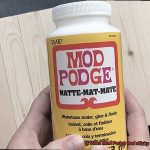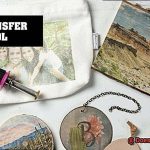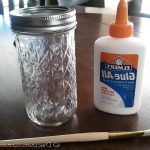Crafters, DIY enthusiasts, and creative professionals alike have all faced the cardboard conundrum. When it comes to joining those cardboard pieces together, hot glue often steals the spotlight as the go-to adhesive. But does hot glue really have what it takes to stick it out with this versatile material?
Get ready to dive into the world of hot glue and cardboard as we unravel the truth behind their bond. With expert insights and real-life experience, we’ll explore the unique qualities of both materials and determine if they make a match made in crafting heaven.
Join us on this investigative journey where we’ll uncover whether hot glue truly sticks to cardboard. Brace yourself for some enlightening information that will revolutionize your crafting projects.
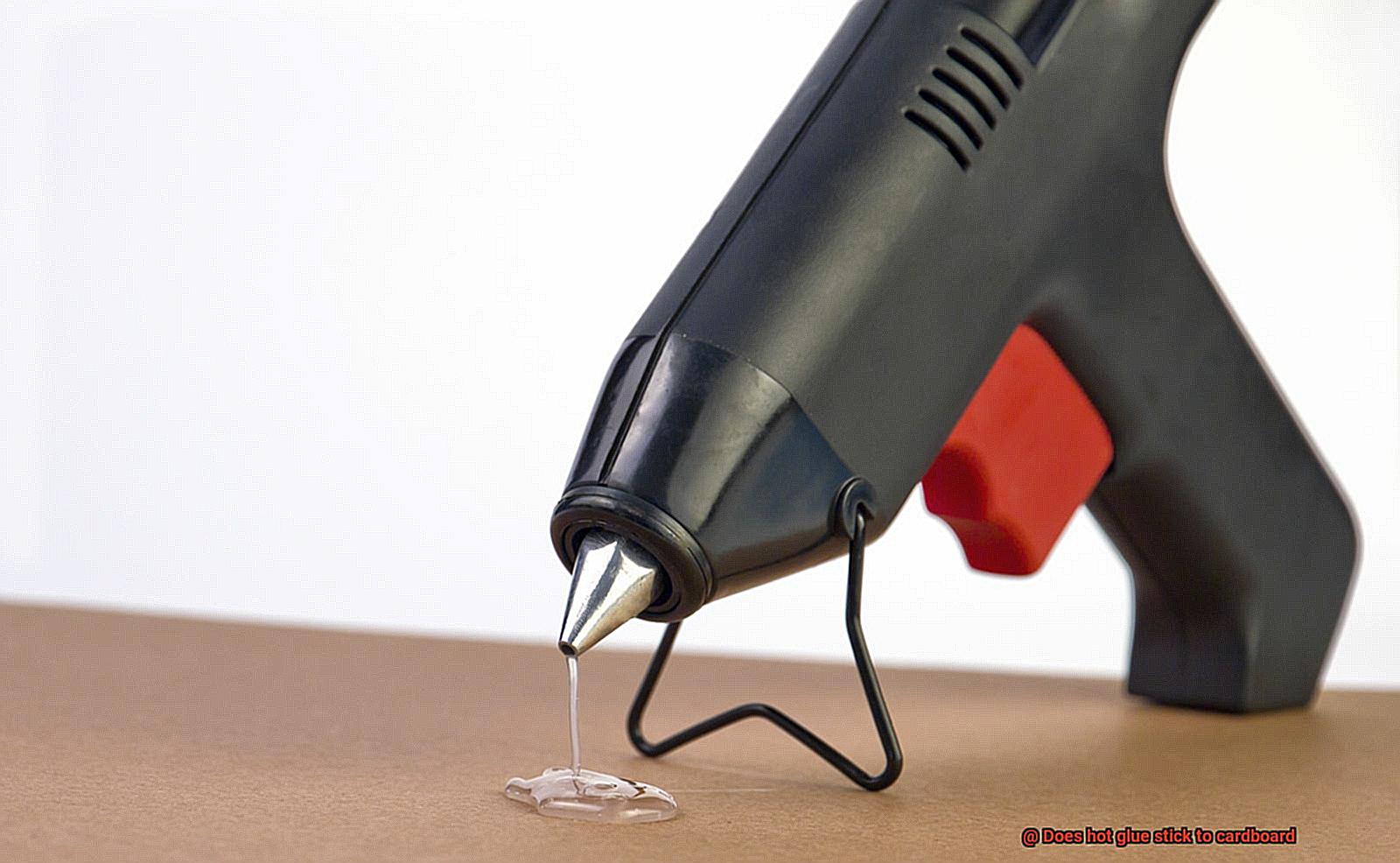
Adhesive Properties of Hot Glue
Contents
- 1 Adhesive Properties of Hot Glue
- 2 Preparing the Cardboard Surface for Hot Glue
- 3 Temperature Settings for Applying Hot Glue
- 4 Thickness and Weight of Cardboard to Consider with Hot Glue
- 5 Benefits of Using Hot Glue on Cardboard
- 6 Common Mistakes to Avoid When Using Hot Glue on Cardboard
- 7 Additional Adhesives for Bonding Cardboard
- 8 Conclusion
When it comes to sticking cardboard together, finding the perfect adhesive can be a daunting task. But fear not. Hot glue is here to save the day with its incredible adhesive properties. In this blog post, we will delve into the world of hot glue and explore why it is the ultimate choice for bonding cardboard. From its ability to penetrate tiny gaps to its quick-drying nature, hot glue is a force to be reckoned with. So let’s dive in and discover the power of hot glue for all your cardboard projects.
The Magic Behind Hot Glue’s Bond:
Hot glue is a superhero among adhesives, and when it comes to cardboard, it works wonders. The porous nature of cardboard allows hot glue to seep into every nook and cranny, creating a bond that is both strong and secure. No matter if you’re working with corrugated cardboard or chipboard, hot glue has got you covered.
Advantages That Set Hot Glue Apart:
One of the greatest advantages of using hot glue on cardboard is its lightning-fast drying time. Unlike other adhesives that leave you anxiously waiting for them to set, hot glue solidifies within seconds of application. This means you can confidently handle your glued items without worrying about them shifting or falling apart before the adhesive sets.
Versatility is another key feature of hot glue. It effortlessly adheres to both new and recycled cardboard surfaces, making it perfect for all your upcycling or crafting endeavors. With hot glue in your toolkit, there are no limits to what you can create.
Top Tips for Optimal Bonding:
To ensure the best results when using hot glue on cardboard, keep these tips in mind:
- Cleanliness is crucial: Before applying hot glue, make sure your cardboard surfaces are clean and free from any dust, oil, or contaminants. Debris on the cardboard can weaken the adhesive properties of hot glue, so a clean surface is key.
- Temperature matters: Most glue guns have adjustable settings. For cardboard applications, opt for a low to medium temperature to avoid warping or burning the cardboard. Strike the perfect balance and achieve a flawless bond.
- Consider thickness and weight: If you’re working with thicker or heavier cardboard, using a hot glue formulated for heavy-duty applications can provide added strength. Applying hot glue in multiple spots or lines can also evenly distribute the bonding power.
Preparing the Cardboard Surface for Hot Glue
Preparing the cardboard surface before applying hot glue is a crucial step in ensuring a bond that is as strong as Hulk’s biceps. To achieve this, follow these important steps:
- Clean the surface: Begin by wiping the cardboard surface with a damp cloth or sponge to remove any dust, dirt, or grease that may be lurking. This will provide a clean canvas for the hot glue to work its magic.
- Flatten out bumps and bends: Nobody wants a lumpy mess, so it’s essential to straighten out any bumps or bends in the cardboard. Place heavy objects on top of the cardboard or use a flat surface with even pressure to flatten it out. Your hot glue will thank you for providing a smooth and even surface.
- Sand the surface (optional): If you’re aiming for a bond that could withstand a hurricane, consider lightly sanding the cardboard surface. Gently roughen up the surface using fine-grit sandpaper. This creates more texture for the glue to grip onto, resulting in an even stronger hold.
- Prime the surface (optional): For porous or glossy cardboard surfaces, giving them a little primer love can make a big difference. Apply a thin layer of primer using a brush or sponge and let it dry completely before moving on to the glue application. This superhero sidekick helps the glue stick better and prevents it from seeping into those pesky porous surfaces.
- Test it out: Before going all-in on your project, do a small test on a hidden or inconspicuous area. Apply a small amount of hot glue and let it dry completely. Give it a good tug to see if it holds strong. If all looks good, then you’re ready to unleash the full power of hot glue on your cardboard creation.
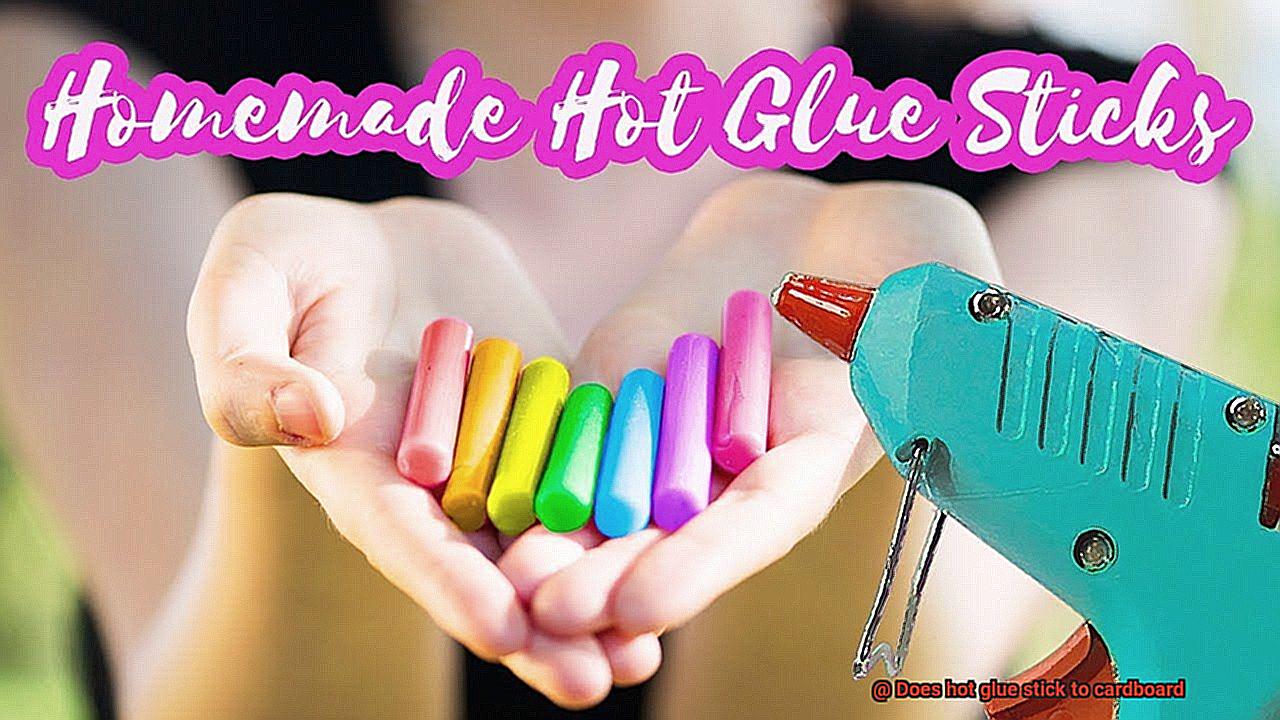
Temperature Settings for Applying Hot Glue
Today, we delve into the world of temperature settings for applying hot glue to cardboard. Discover the secrets to unleashing your creativity while keeping your projects safe and secure.
The Magic of Low Temperatures
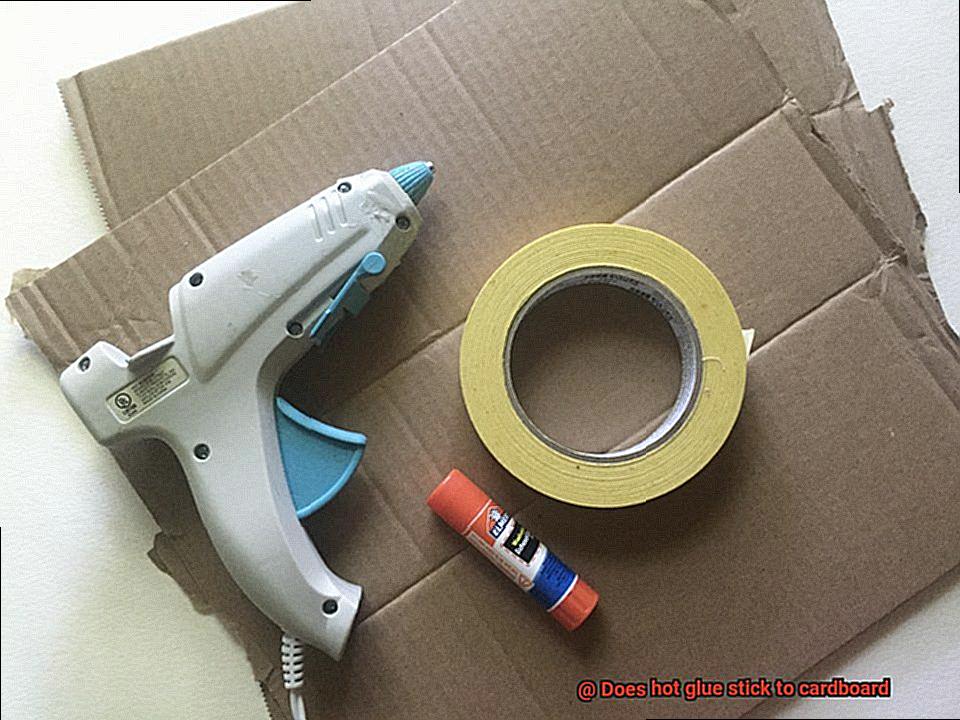
Let’s start with the basics – when it comes to cardboard, low temperature settings are your best friend. Why? High temperatures can turn your project into a fiery disaster (and nobody wants that.). So, play it cool and embrace the power of low heat. It ensures a secure bond without any damage or warping. Feel the thrill of crafting with confidence.
Gradually Cranking Up the Heat
Sometimes, low temperatures may not provide enough bonding strength, especially when working with thicker or denser cardboard. Fear not. You possess the power to gradually increase the temperature to medium.
It’s like giving your glue gun a little boost, perfect for tackling those more challenging projects. Embrace the heat and watch your creations come to life.
Safety First, Superheroes.
Remember, even at lower temperatures, hot glue can still cause burns. So, before you become a crafting superhero, make sure to protect yourself with gloves or finger guards. Safety should always be your sidekick. Shield yourself from harm and unleash your crafting powers fearlessly.
The Power of Testing
Just like superheroes need practice before saving the day, it’s crucial to test the adhesive strength of your hot glue on a small piece of cardboard first. This way, you ensure that your chosen temperature setting provides the right level of adhesion without compromising the integrity of your masterpiece. Harness the power of experimentation and watch as your skills soar.
Thickness and Weight of Cardboard to Consider with Hot Glue
Today, we will unravel the secrets behind achieving picture-perfect results by delving into the impact of cardboard thickness and weight on hot glue bonds.
Let’s start with thickness, the backbone of your project. Thicker cardboard serves as a solid foundation for hot glue, providing ample surface area for a robust bond. It’s the ideal choice for heavy-duty tasks or projects involving weighty objects. With thicker cardboard, you can trust that your hot glue will work its magic, ensuring your creation stands the test of time.
But what about thinner cardboard? Fear not, for it presents an exciting challenge rather than a roadblock. Though thinner cardboard offers less real estate for hot glue to grip onto, you can compensate by evenly distributing the adhesive and covering a larger area on the cardboard. This strategic approach maximizes the adhesive capabilities, resulting in a bond that will astonish even the most skeptical critics.
Now let’s shift our focus to weight. If your project involves lightweight objects or small decorations, consider hot glue as your go-to adhesive across various thicknesses of cardboard. It acts as a trusty sidekick, providing sufficient bonding power to keep everything securely in place. However, when tackling heavyweight applications or objects that demand extra strength and durability, opt for thicker and sturdier cardboard paired with hot glue. This dynamic duo ensures your project can withstand whatever challenges it may encounter.
Before we conclude, remember that every hero has its limits. While hot glue possesses strength, it is not invincible. For extremely heavy objects or applications that require maximum strength and durability, it’s time to call in reinforcements. Epoxy or construction adhesive are specialized options designed for heavy-duty bonding, providing the extra muscle your project needs.
In summary, understanding the impact of cardboard thickness and weight on hot glue’s adhesive properties empowers you to conquer any cardboard challenge with finesse. Strive to find the sweet spot between thickness and weight, and unleash your creativity with confidence.
Benefits of Using Hot Glue on Cardboard
When it comes to the world of crafting with cardboard, finding the perfect adhesive can make or break your project. Look no further than hot glue – the superhero of adhesives for cardboard creations. In this article, we will explore the advantages of using hot glue on cardboard, from its exceptional bonding abilities to its versatility and ease of use. So grab your trusty hot glue gun and let’s dive into the world of hot glue magic.
Unbreakable Bonds:
Hot glue is renowned for its ability to create unbreakable bonds, and when applied to cardboard, it forms a strong and durable connection. This makes it ideal for projects that require stability and longevity, such as constructing models or assembling sturdy cardboard boxes.
Lightning-Fast Drying Time:
Time is of the essence when working on creative projects, and hot glue swoops in to save the day with its rapid drying time. Within seconds, the hot glue sets, allowing you to continue working without any frustrating delays. Bid farewell to tedious waiting times for adhesive to dry.
Boundless Versatility:
Hot glue is a versatile superstar that can be used for countless applications on cardboard. Whether you want to affix embellishments, decorations, or even fabric onto your cardboard masterpiece, hot glue has got you covered. The ability to apply hot glue in various patterns or shapes also opens up a world of creative possibilities for intricate designs on your cardboard creations.
Effortless Application:
Using hot glue on cardboard couldn’t be simpler. With just a hot glue gun and a steady hand, you can apply hot glue with ease and precision. The glue gun heats up the glue stick, which melts and can then be smoothly dispensed onto the desired area of the cardboard. No complex techniques or messy application processes – just seamless gluing at your fingertips.
Budget-Friendly Benefits:
Crafting should never empty your wallet, and hot glue ensures that it doesn’t. Hot glue sticks are affordable and widely available in craft stores or online. Furthermore, since hot glue forms strong bonds, you won’t need to use excessive amounts of glue, saving you even more money in the long run.
Flawlessly Clean Finish:
One of the striking advantages of using hot glue on cardboard is the clean and neat finish it provides. Unlike some adhesives that leave behind residue or require additional cleanup, hot glue leaves no mess when applied correctly. This is especially crucial when aesthetics matter, such as when creating gift boxes or display items.
Common Mistakes to Avoid When Using Hot Glue on Cardboard
Hot glue is a fantastic adhesive for bonding cardboard, but using it incorrectly can lead to messy projects and weak bonds. In this article, we will explore the common mistakes to avoid when using hot glue on cardboard. By understanding these pitfalls, you can ensure your projects are sturdy and visually appealing.
Using Too Much Hot Glue:
One of the biggest mistakes people make when using hot glue on cardboard is using too much glue. While it may seem like more glue will make the bond stronger, it actually creates a messy and uneven surface. To avoid this, use just enough glue to create a secure bond without excess oozing out.
Not Allowing the Hot Glue to Fully Heat Up:
Patience is key when working with hot glue. Many people make the mistake of not allowing the glue gun to fully heat up before applying it to cardboard. Applying it too early can result in a weak bond that easily comes apart. Be patient and wait for the glue gun to reach its optimal temperature before using it.
Uneven Application:
To ensure a strong bond, it is important to apply the hot glue evenly across the surface of the cardboard. Uneven application can lead to weak spots in the bond and compromise the overall sturdiness of your project. Take your time and distribute the glue evenly for a solid and secure bond.
Insufficient Pressure:
Another common mistake is not applying enough pressure when using hot glue on cardboard. Pressing down firmly when applying the hot glue is crucial for creating a strong bond. Hold the glued pieces together until the glue has cooled and hardened. This will ensure that the bond is secure and long-lasting.
Using Low-Quality Hot Glue:
Investing in a good-quality hot glue gun and using high-quality hot glue sticks specifically designed for bonding cardboard is essential. Low-quality adhesives may not heat up properly or provide a strong enough bond, compromising the integrity of your project. Opt for reliable and reputable brands to ensure the best results.
Environmental Considerations:
Be mindful of the temperature and humidity conditions when using hot glue on cardboard. Extreme temperatures or high humidity can affect the adhesive properties of hot glue. Whenever possible, work in a controlled environment to ensure optimal bonding. Avoid working in extremely hot or cold conditions, as well as in areas with high moisture levels.
Additional Adhesives for Bonding Cardboard
Step into a world beyond hot glue and unlock the potential of new adhesives for bonding cardboard. While hot glue is a popular choice, there are other alternatives that can provide equally strong and durable bonds for your creative cardboard projects. Let’s dive into the realm of additional adhesives, where possibilities abound and innovation awaits.
Liquid Glue:
Liquid glue, like white craft glue or wood glue, offers an excellent alternative for bonding cardboard. Designed specifically for porous materials like cardboard, these glues create a formidable bond when applied correctly. What sets liquid glue apart is its longer drying time, allowing you to adjust and perfect the position of your cardboard creation before it sets completely. With this flexibility, your crafting adventures will know no bounds.
Double-Sided Tape:
Convenience and ease of use come together in the form of double-sided tape. This adhesive provides a strong bond between two surfaces, making it an ideal choice for bonding cardboard. But beware. Not all tapes are created equal. Opt for a heavy-duty version designed specifically for applications such as bonding cardboard, as regular office tape may not hold up well. Simply apply the tape evenly and press the surfaces together firmly to achieve a secure bond in an instant.
Spray Adhesives:
When faced with large or irregularly shaped pieces of cardboard, spray adhesives become your best friends. These magical adhesives offer quick and even application, making them perfect for tackling those challenging projects. Be sure to select a spray adhesive specifically designed for porous materials like cardboard, follow the instructions provided by the manufacturer diligently, and remember to provide proper ventilation during application. Spray away and conquer your cardboard conquests with ease.
Epoxy Adhesive:
For those seeking superior strength and durability, epoxy adhesive is the secret weapon you’ve been waiting for. This two-component adhesive, consisting of resin and hardener, must be mixed before application. Once cured, epoxy adhesive forms a bond that can withstand heavy loads and resist moisture. However, be prepared for a shorter working time and longer curing time compared to other adhesives. The extra effort pays off with an unbreakable bond that will stand the test of time.
UczcKRBznOE” >
Also Read: How Much Weight Can Hot Glue Hold?
Conclusion
In conclusion, hot glue and cardboard are a match made in crafting heaven. The exceptional adhesive properties of hot glue make it the go-to choice for sticking cardboard in various projects. Its lightning-fast drying time ensures that your glued items won’t shift or fall apart before the adhesive sets.
Hot glue has a magical ability to seep into every nook and cranny of porous cardboard, creating a bond that is both strong and secure. It solidifies within seconds, allowing you to confidently handle your creations without fear of them coming undone.
To achieve optimal bonding with hot glue on cardboard, cleanliness is key. Make sure your surfaces are free from dust and contaminants before applying the glue. Temperature settings also matter – keep it low to medium to avoid warping or burning the cardboard. And consider the thickness and weight of your cardboard – thicker provides a solid foundation, while thinner can be compensated by evenly distributing the adhesive.
While hot glue is an excellent choice for bonding cardboard, there are other alternatives available such as liquid glue, double-sided tape, spray adhesives, and epoxy adhesive. These options can provide equally strong bonds depending on your specific project needs.
So, whether you’re constructing models, assembling sturdy boxes, or unleashing your creativity on intricate designs, hot glue is here to save the day.




